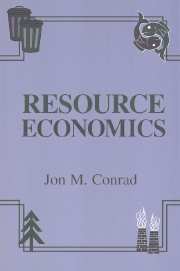Book contents
4 - The Economics of Forestry
Published online by Cambridge University Press: 05 June 2012
Summary
Introduction and Overview
In this chapter we will examine the economics of even-aged forestry and the optimal inventory of old-growth forest. By an even-aged forest we mean a forest that contains trees of the same species and age. Such a forest might be established by a lightning-induced fire or by clear-cutting of a stand of trees. The first non-native settlers in western Washington and Oregon encountered vast stretches of even-aged forest (predominantly Douglas fir) which had been established by natural (“volunteer”) reseeding following a fire. Today, silvicultural practices by forest firms are specifically designed to establish an age-structured forest inventory or “synchronized forest,” where tracts of land contain cohorts ranging in age from seedlings to “financially mature” trees, that provide the forest firm with a more or less steady flow of timber to their mills.
In western Washington and Oregon in the mid-1800s most forest stands contained trees over 200 years old with diameters in excess of five feet. Collectively, these forests constituted a huge inventory of old-growth timber, which was used in the construction of houses and commercial buildings, the building of ships, and the manufacture of railroad ties, telegraph poles, furniture, musical instruments, and a plethora of other items. In the 1850s the old-growth forests of the Pacific Northwest must have seemed limitless and inexhaustible, but by the 1920s foresters were already contemplating the end of this period of “old-growth mining” and the establishment of a forest economy based on the sustainable harvest of timber from even-aged forest “plantations.”
- Type
- Chapter
- Information
- Resource Economics , pp. 59 - 76Publisher: Cambridge University PressPrint publication year: 1999



